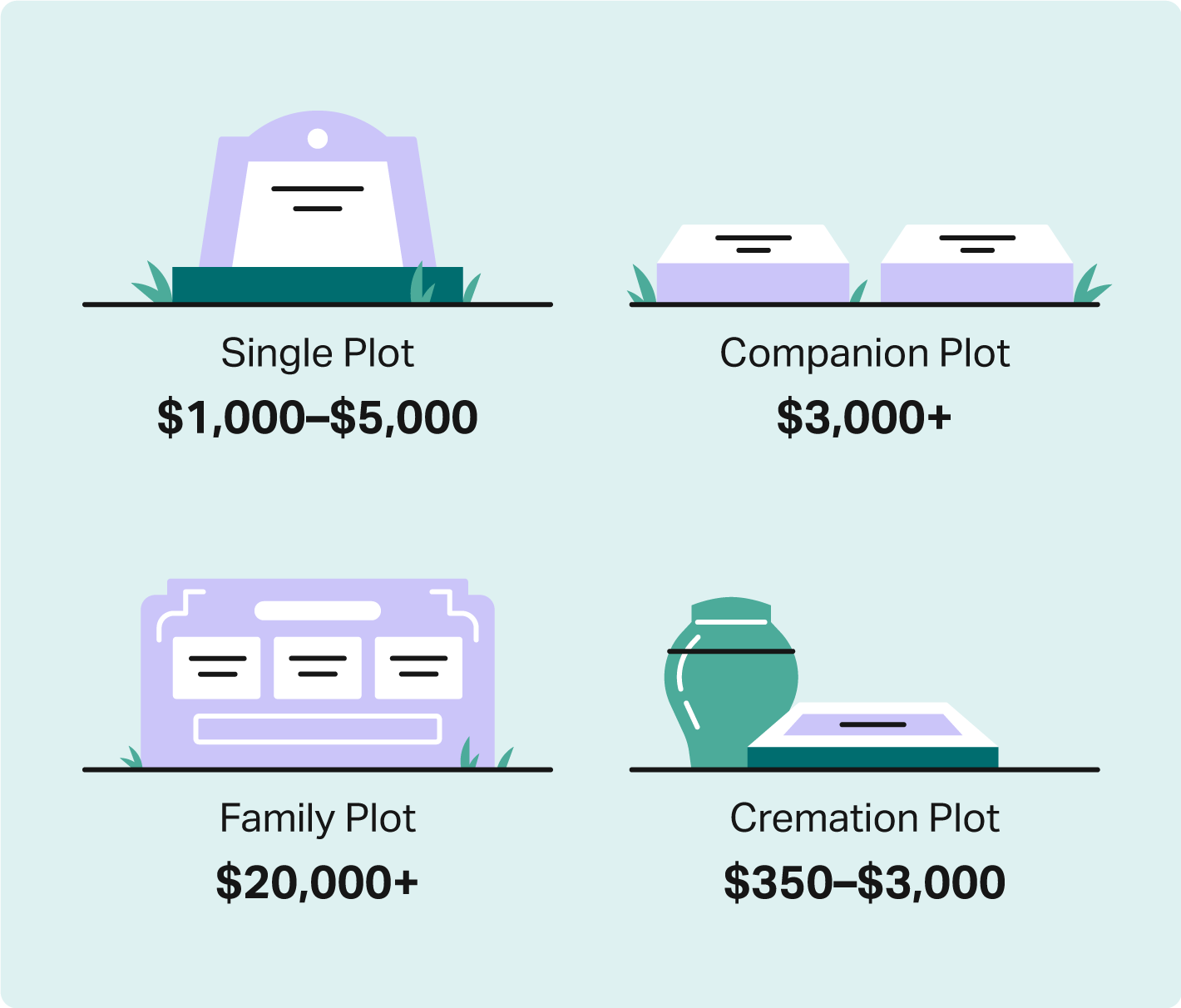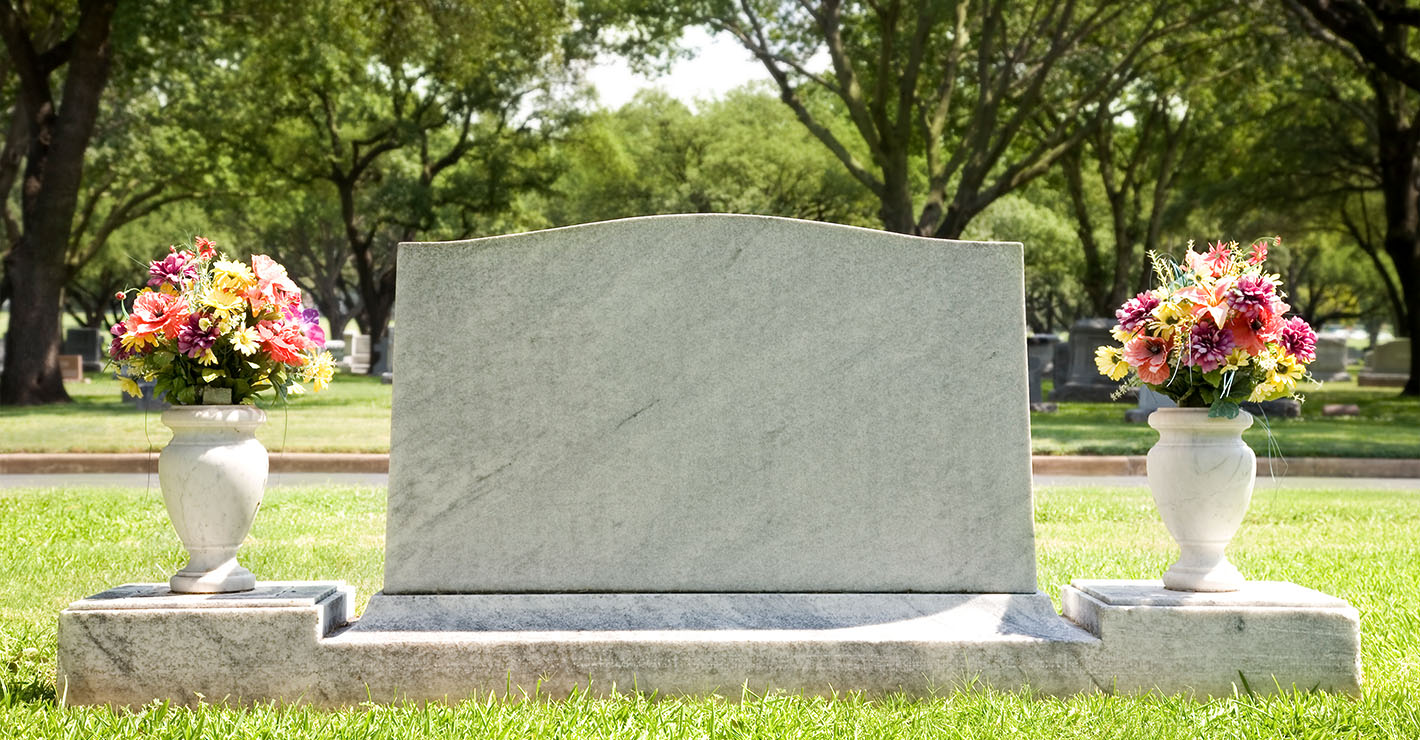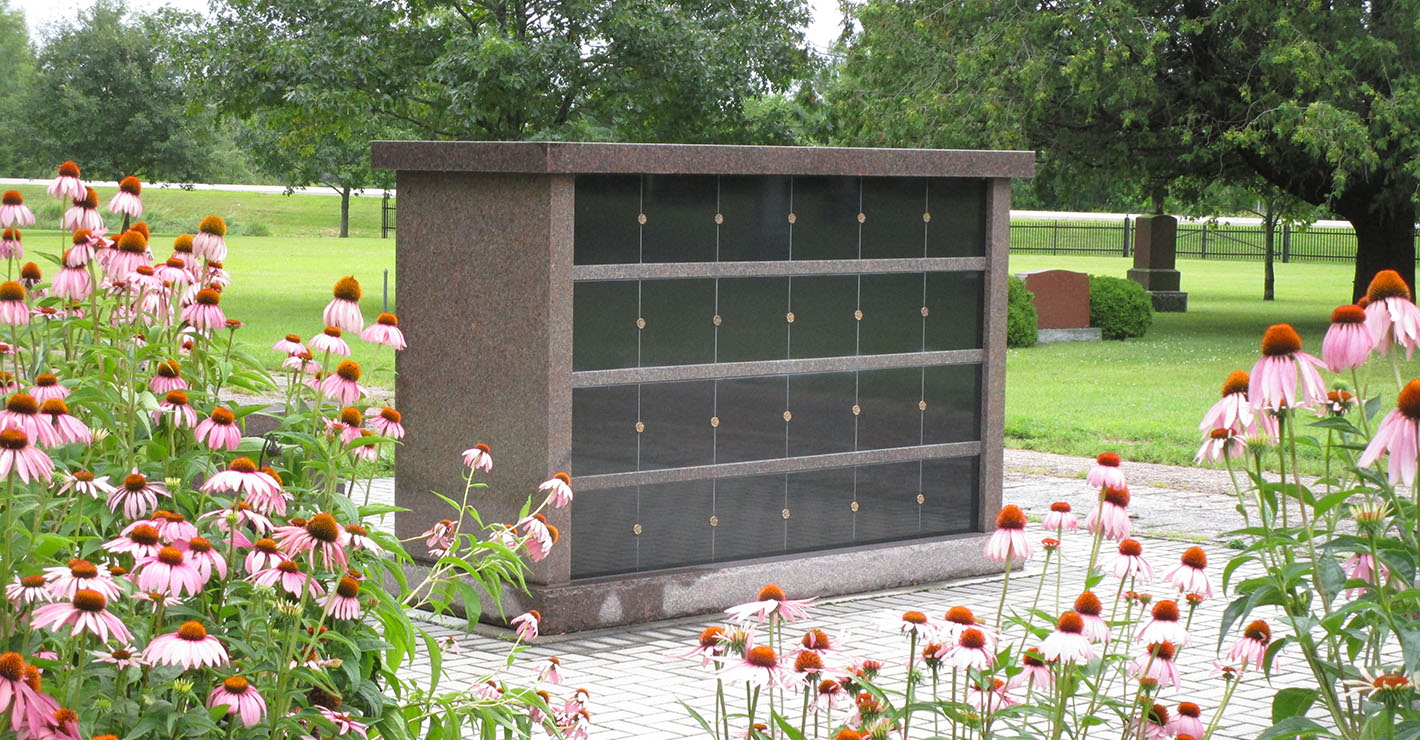A burial plot — also known as a grave space — can be an expensive purchase. In this guide, we’ll walk you through everything there is to know about burial plot costs and how to choose the best option.
Cost By Plot Type

Buying a burial plot doesn’t mean you own that piece of land, but rather the right to be buried in that space. For this reason, burial plot costs may also include interment or “cemetery service” fees, such as:
- Opening and closing the grave
- Headstone installment
- Ground maintenance
Nevertheless, there are many burial plot options for you or your loved ones, which we’ll explore below.
Single plot
Single plots, which hold one person or casket, are the most common burial options. The cost of single plots ranges from $1,000 to $5,000 and usually includes interment services and burial permits. Keep in mind that public cemeteries are usually cheaper than private cemeteries, which can run $5,000–$10,000 for single burial plots.
Companion plot
A companion or “double” plot is a burial plot large enough for two graves, with the options of side-by-side or stacked burials. Companion plots cost around $3,000 or more, but prices vary depending on the cemetery. This type of plot is usually offered to married couples and life partners.
Family plots
Family plots, also known as “estate plots,” are spacious private areas in graveyards that are designated for generations of family burials. A family plot costs much more, starting around $20,000, and generally accommodates at least six family members. It’s a good idea to purchase family plots in advance to ensure spots are already reserved and help avoid overcrowding at public cemeteries.
Cremation plot
Many cemeteries allow smaller burial plots for urns, also known as “urn plots,” for burying cremated remains. The cost of cremation plots ranges from $350 to $3,000 and typically includes the cost of an urn and cemetery fees. Some cemeteries may require an urn vault or placement in a columbarium — an aboveground building for urns — which will be an additional cremation burial fee.
Alternative Burial Plots
If you’re planning your funeral and looking for ways to personalize or save money on the burial, consider the following plot alternatives.
Green Burial Plot
Green burial plot costs can range from $500 to $5,000. A natural (or green) burial plot is an eco-friendly alternative to traditional burial plots, where the cemetery grounds prohibit certain items and methods of interment — embalming, casket liners, vaults — to allow natural decomposition. It also involves using biodegradable caskets and choosing conservation cemeteries.
Pre-Owned Burial Plot
A pre-owned plot is generally less expensive than purchasing one from a cemetery and is usually easier to negotiate. In these cases, a burial plot owner may choose to sell the property for a lower price. While costs can vary depending on the location and desirability, you may be able to bargain the price if the owner is eager to sell.
Costs By State
Funeral costs can greatly differ by state and region. Below is a snapshot of burial plot prices to expect in the five most and least expensive states.
| Least Expensive States | Most Expensive States |
|---|---|
| Alaska: $3,104 | Connecticut: $4,815 |
| Oregon: $3,188 | Minnesota: $4,655 |
| Arizona: $3,203 | Washington D.C.: $4,641 |
| Arkansas: $3,264 | Iowa: $4,611 |
| Washington: $3,342 | Delaware: $4,452 |
Additional Costs to Consider
In addition to location, factors such as size and type of burial plot will influence the cost. For example, urban areas are generally more expensive than rural areas, and plot sizes for children will be less expensive than those for adults.
When choosing between private vs. public cemeteries, understand that private locations tend to have higher costs and service fees since they’re not subsidized by the city or county.
According to the Funeral Consumer Alliance, the following are other associated burial costs cemeteries may charge if they’re not included in the burial plot cost:
- Burial Permit: $10–$30
- Opening/Closing Grave: $200–$500
- Headstone/Grave Marker: $1,000
- Headstone Installation: $500–$3,000
- Grave Liner: $700–$1,500
- Flowers: $50–$80 per arrangement
- Gravesite Maintenance: 5% to 15% of plot cost
For a more accurate estimate, use our funeral cost calculator.
5 Tips To Save On Burial Plot Costs
Fortunately, there are many strategies to reduce end-of-life expenses. Here are five ways you can save on funeral costs.
1. Use Veteran Benefits
If you or your loved one is a qualified veteran, the U.S. Department of Veterans Affairs (VA) will handle the burial plot and additional services free of charge. Other veteran benefits include:
- Gravesite choice at any VA national cemetery
- Opening and closing of the grave
- Government headstone
- Presidential Memorial Certificate
- Burial Flag
- Perpetual (ongoing) gravesite care
Some families may also qualify for burial allowances to cover other common funeral expenses, such as cremation arrangements and transportation of the deceased.
2. Compare prices
Shop around by calling several different funeral homes for estimates. You can conveniently ask and receive prices over the phone.
3. Purchase in advance
Since burial plot prices can change over time, consider prepaying a cemetery for a plot early to secure a fixed price. A prepaid burial plot is one that is purchased well in advance of the funeral, where you can lock in the price of the plot the day you buy it.
Buying a prepaid plot is a good idea if you’d like to be buried alongside your spouse or other family members. You can also look into pre-owned burial plots and negotiate with those owners.
4. Consider a natural burial
Since natural or “green” burials exclude embalming and vaults, they’re significantly less expensive than traditional burials. Green burials are a good alternative if you or your loved one is looking for an environmentally-friendly choice that also saves on funeral costs.
5. Get burial insurance
Burial insurance, also referred to as “final expense” or funeral insurance, is a whole life insurance policy designed to cover funeral costs and relieve the family from the financial burden. Premiums are available for senior citizens up to age 89, and you can still qualify with preexisting health issues.
Frequently Asked Questions
You can purchase a burial plot in advance by contacting the management company of your cemetery of choice. Your funeral director can also provide assistance and help coordinate.
If plans change and you decide not to use that burial plot you’ve purchased, you may be able to sell it to someone else. However, it’s best to check with your state or local laws, as well as rules and regulations of the cemetery. Some contracts may not allow it or may require you to sell private plots back to the cemetery.
Single burial plots are intended for only one person or casket. You’ll have to purchase a double or “companion” burial plot for two people or a family plot if for several.
To accommodate a burial vault, the recommended grave size for a single plot is 3 feet by 9 feet and 4 feet by 10 feet. The depth of interments should be at least 5 feet. For cremation burials, the depth should be at least 2 feet.
Prepare In Advance With Burial Insurance
Planning a funeral can be stressful, especially when it’s unexpected. Fortunately, burial insurance can help. We’ve analyzed the best burial insurance companies so you can have peace of mind knowing that all funeral costs, medical expenses, and other personal affairs are covered and not forced on your loved ones while in mourning.
- Nationally licensed life insurance agent with over 15 years of experience
- Personal annual production that puts him in the top .001% out of all life insurance agents in the nation.
Anthony Martin is a nationally licensed insurance expert with over 15 years of experience and has personally served over 10,000 clients with their life insurance needs. He frequently authors entrepreneurial and life insurance content for Forbes, Inc.com, Newsweek, Kiplinger, and Entreprenuer.com. Anthony has been consulted as an expert life insurance source for dozens of high-profile websites such as Forbes, Bankrate, Reuters, Fox Business, CNBC, Investopedia, Insurance.com, Yahoo Finance, and many more.
- Nationally licensed life insurance agent with over 19 years of experience
- Best selling Amazon author.
Jeff Root is a nationally licensed life insurance expert with over 19 years of experience. He has personally helped over 3000 clients with their life insurance needs. Jeff is a best-selling Amazon author and the managing partner of a highly successful insurance brokerage that manages over 2,500 licensed insurance agents across the USA. He has been a featured life insurance source for prestigious websites such as Forbes, Bloomberg, MarketWatch, Nerdwallet, and many more.
- Nationally licensed life insurance agent with over 14 years of experience
- Best selling Amazon author of five insurance sales books.
David Duford is a nationally licensed insurance expert with over 14 years of experience. He has personally helped more than 15,000 clients buy life insurance. David has been featured as an expert source for highly authoritative publications such as A.M. Best and Insurancenewsnet. He also runs one of the largest Youtube channels to help aspiring insurance agents serve their clients better.
- Nationally licensed life insurance agent with over 19 years of experience
- Best selling Amazon author.
Jeff Root is a nationally licensed life insurance expert with over 19 years of experience. He has personally helped over 3000 clients with their life insurance needs. Jeff is a best-selling Amazon author and the managing partner of a highly successful insurance brokerage that manages over 2,500 licensed insurance agents across the USA. He has been a featured life insurance source for prestigious websites such as Forbes, Bloomberg, MarketWatch, Nerdwallet, and many more.
- Nationally licensed life insurance agent with over 14 years of experience
- Best selling Amazon author of five insurance sales books.
David Duford is a nationally licensed insurance expert with over 14 years of experience. He has personally helped more than 15,000 clients buy life insurance. David has been featured as an expert source for highly authoritative publications such as A.M. Best and Insurancenewsnet. He also runs one of the largest Youtube channels to help aspiring insurance agents serve their clients better.
Choice Mutual often cites third-party websites to provide context and verification for specific claims made in our work. We only link to authoritative websites that provide accurate information. You can learn more about our editorial standards, which guide our mission of delivering factual and impartial content.
-
right to be buried. https://funerals.org/?consumers=consumers-guide-cemetery-purchases
-
$3,000. https://www.orlando.gov/Our-Government/Make-a-Payment/Purchase-a-Cemetery-Plot/Cemetery-Plot-Prices
-
$500 to $5,000. https://www.us-funerals.com/green-burial-directory/#.ZBon6uzML0s
-
Funeral Consumer Alliance. https://funerals.org/?consumers=consumers-guide-cemetery-purchases
-
U.S. Department of Veterans Affairs. https://www.cem.va.gov/burial_benefits/
-
recommended grave size. https://iccfa.com/blog/the-subdividing-of-a-cemetery-into-sections-lots-and-single-grave-districts/













